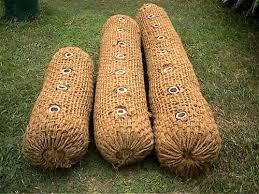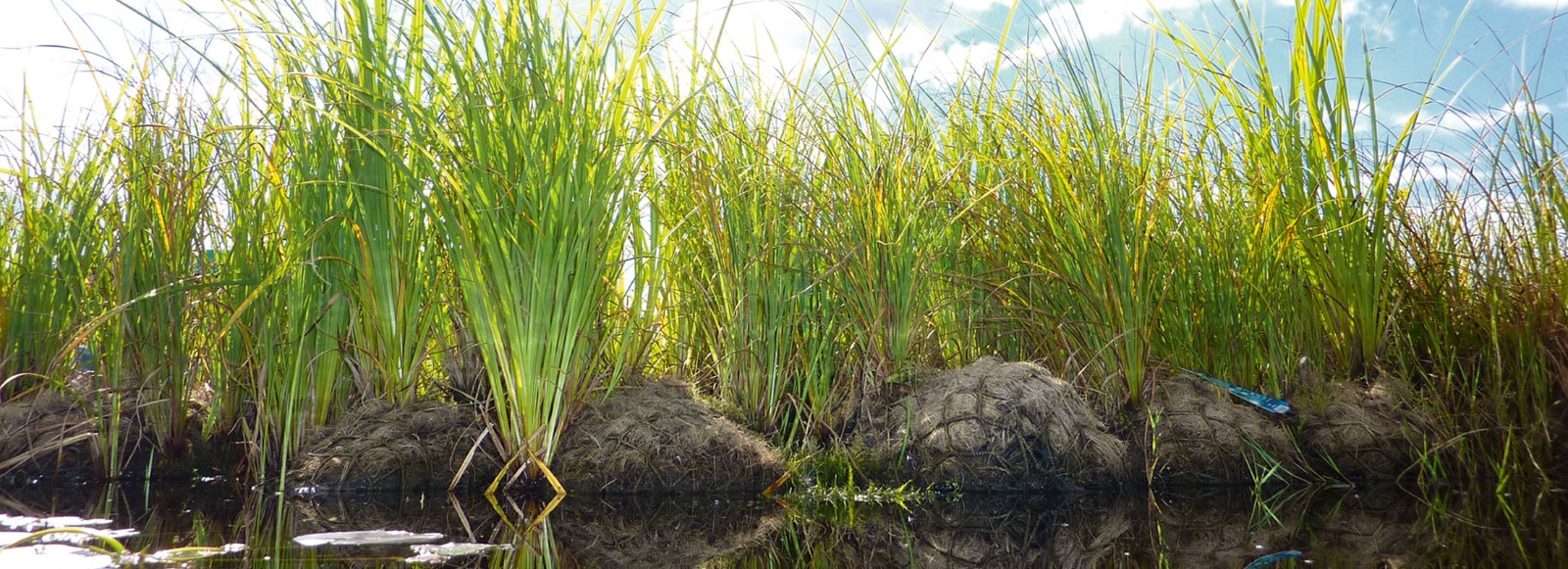Waterlogs
Coir waterlogs are an excellent choice for a variety of applications, including construction zones, restoration areas, hillside preservation, and aquatic erosion control. Constructed from 100% natural coir fibers compressed within tubular mesh netting, these waterlogs are robust enough to endure harsh weather conditions, such as heavy rains. They function effectively to prevent soil slippage by holding water on hillsides until sediment settles. Their design not only facilitates easy placement and installation but also creates a natural control area that supports vegetation growth and controls erosion. The use of coir waterlogs thus offers a practical, eco-friendly solution for managing soil and water in challenging environments.

Coir Log Net

Planting Hole

Polypropylene Log Net
Usage of Waterlogs
- Wetland Restoration: Rehabilitating wetlands can help absorb excess water, reduce runoff, and stabilize soil. Wetlands act as natural filters and provide habitat, which helps in controlling erosion.
- Vegetative Buffers: Planting vegetation along the edges of waterlogged areas can help stabilize soil and absorb excess moisture. Native grasses, shrubs, and trees are particularly effective in these areas.
- Check Dams: Small check dams made of logs, rocks, or other materials can slow down water flow and reduce erosion in areas with significant waterlogging.
- Contour Farming: On sloped terrains, planting along the contours can help slow down water flow and reduce erosion. This technique is especially useful in areas prone to waterlogging.
- Constructed Wetlands: These artificial wetlands can be designed to manage excess water, filter pollutants, and provide habitat while controlling erosion.
- Rain Gardens: Designing rain gardens to capture and infiltrate runoff from waterlogged areas helps in managing excess water and reducing soil erosion.
- Gully Plugging: For areas with erosion-prone gullies, constructing gully plugs (e.g., with rocks or vegetation) can help slow water flow and reduce erosion.
- Drainage Systems: Installing proper drainage systems, such as French drains or perforated pipes, can help manage excess water and reduce waterlogging, thus minimizing erosion.
Benefits of Waterlogs
- Soil Stability: Effective erosion control prevents soil from being washed away, maintaining soil structure and stability. This is crucial for preserving the land’s ability to support vegetation and prevent land degradation.
- Reduced Sedimentation: By controlling erosion, sedimentation in nearby water bodies (like rivers, lakes, and streams) is reduced. This helps maintain water quality, prevent siltation, and protect aquatic habitats.
- Improved Water Quality: Erosion control measures help filter pollutants and excess nutrients from runoff before they enter water systems, leading to better water quality and reduced risk of eutrophication.
- Enhanced Vegetation Growth: Stabilizing waterlogged soils can create more favorable conditions for plant growth. Healthy vegetation further helps in controlling erosion and providing habitat for wildlife.
- Agricultural Productivity: For agricultural lands, controlling erosion helps maintain soil fertility and prevents the loss of valuable topsoil, which is essential for crop production.
- Flood Reduction: By managing water flow and reducing runoff, erosion control measures can help mitigate flooding risks and manage excess water more effectively.
- Habitat Preservation: Erosion control helps preserve natural habitats and ecosystems by maintaining the integrity of soil and preventing the loss of critical habitat for various species.
- Long-Term Sustainability: Erosion control practices contribute to the long-term sustainability of land use and management, ensuring that natural resources are preserved for future generations.
| Diameter | 30 cm/ 40 cm/ 50 cm |
| Length | 1 m – 3 m |
| Unit Weight | Customized |

